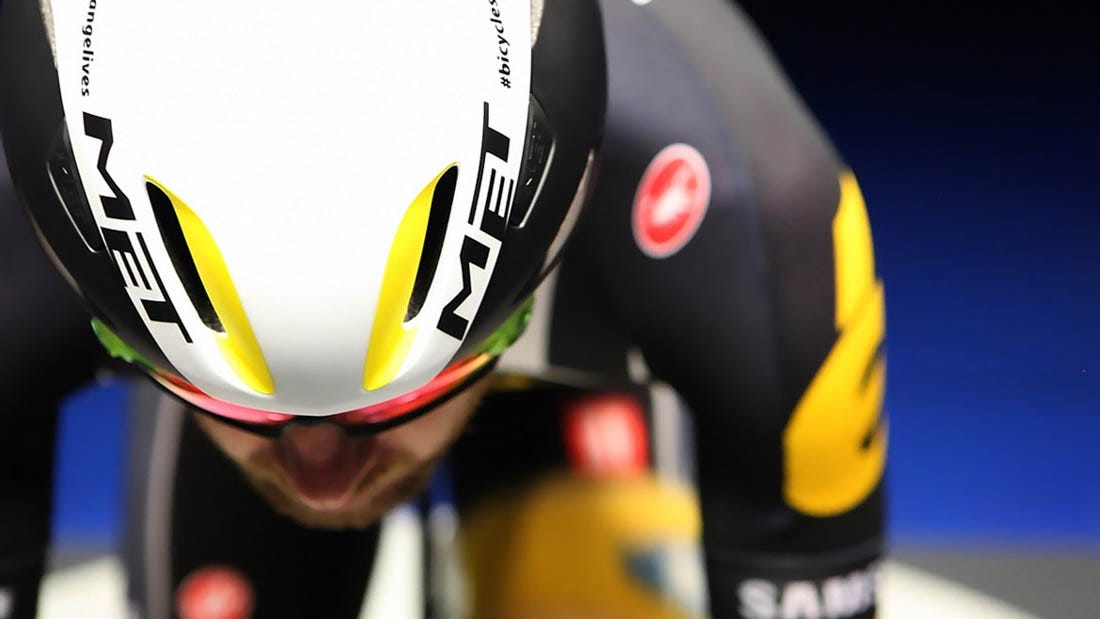Helmets Buying Guide

By law, every cyclist is required to wear a helmet which complies with Australia’s strict safety standards. As well as being safe, your helmet also needs to be comfortable and suited to the type of riding you’ll be doing. Here’s a rundown on some of the main types of helmets and how to pick which model is right for you.
Road Helmets
 Road helmets generally feature lightweight aerodynamic designs which help reduce wind resistance and provide ventilation around the rider’s head. When buying a road helmet, it is important to ensure that you select the correct size in order to ensure a comfortable, yet secure fit. To determine what size you’ll need, simply measure the circumference of your head using a piece of string placed about 3 cm above your eyebrows. A well-fitting helmet should be snug but not uncomfortable. Most cycling helmets will also feature a retention system (normally in the form of a dial adjuster) which allows you to fine tune your fit.
Road helmets generally feature lightweight aerodynamic designs which help reduce wind resistance and provide ventilation around the rider’s head. When buying a road helmet, it is important to ensure that you select the correct size in order to ensure a comfortable, yet secure fit. To determine what size you’ll need, simply measure the circumference of your head using a piece of string placed about 3 cm above your eyebrows. A well-fitting helmet should be snug but not uncomfortable. Most cycling helmets will also feature a retention system (normally in the form of a dial adjuster) which allows you to fine tune your fit.
Mountain Bike Helmets
 Mountain bike helmets can normally be distinguished by the presence of a front visor and additional protection around the rear of the head. It is important to buy a mountain bike helmet that is a snug fit as the last thing that you want is for your helmet to move around when you’re flying down a steep descent. You can determine your size by measuring the circumference of your head approximately 3 cm above your eyebrows. Finally, if you’re going to be riding in warmer climates, look for a model that features generous ventilation vents to ensure maximum cooling airflow at low speeds (for when you’re climbing).
Mountain bike helmets can normally be distinguished by the presence of a front visor and additional protection around the rear of the head. It is important to buy a mountain bike helmet that is a snug fit as the last thing that you want is for your helmet to move around when you’re flying down a steep descent. You can determine your size by measuring the circumference of your head approximately 3 cm above your eyebrows. Finally, if you’re going to be riding in warmer climates, look for a model that features generous ventilation vents to ensure maximum cooling airflow at low speeds (for when you’re climbing).
Full Face helmets
 If you’re serious about your downhill mountain biking or BMX racing, you’ll definitely want to invest in a full face helmet. These type of helmets provide full protection around your head, including your face, which is essential when you’re travelling at high speeds amongst immovable obstacles (such as trees) or getting horizontal around a tight berm on a BMX track. Look for a model that is lightweight (around 700-800 grams) and well ventilated to ensure that you’re as comfortable as possible when making your way to the top of the mountain.
If you’re serious about your downhill mountain biking or BMX racing, you’ll definitely want to invest in a full face helmet. These type of helmets provide full protection around your head, including your face, which is essential when you’re travelling at high speeds amongst immovable obstacles (such as trees) or getting horizontal around a tight berm on a BMX track. Look for a model that is lightweight (around 700-800 grams) and well ventilated to ensure that you’re as comfortable as possible when making your way to the top of the mountain.
BMX helmets
 BMX & skate helmets are generally designed with two things in mind; safety and style These type of helmets generally aren’t as aerodynamically designed as other helmets, but what they lack in aero efficiency, the make up with good looks and steeze at the skatepark. As with any helmet it’s important to get the right size for your head which can be determined by measuring the circumference of your head roughly 3 cm above your eyebrows.
BMX & skate helmets are generally designed with two things in mind; safety and style These type of helmets generally aren’t as aerodynamically designed as other helmets, but what they lack in aero efficiency, the make up with good looks and steeze at the skatepark. As with any helmet it’s important to get the right size for your head which can be determined by measuring the circumference of your head roughly 3 cm above your eyebrows.
Kids helmets
 When buying a children’s bike helmet, the same guidelines apply as if you were buying a helmet for yourself - it needs to be comfortable, durable and the correct size You should also ensure that you choose a helmet colour/ design that your child will love to ensure that they’ll want to wear it every time they jump on their bike.
When buying a children’s bike helmet, the same guidelines apply as if you were buying a helmet for yourself - it needs to be comfortable, durable and the correct size You should also ensure that you choose a helmet colour/ design that your child will love to ensure that they’ll want to wear it every time they jump on their bike.
 Your store
Your store 



